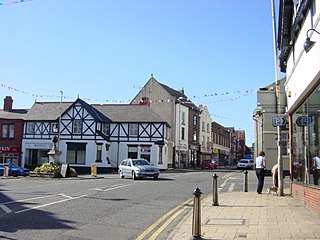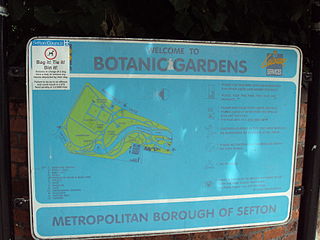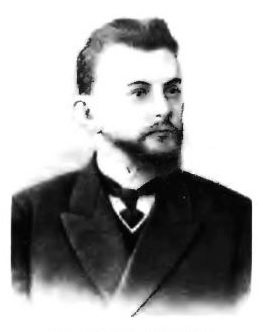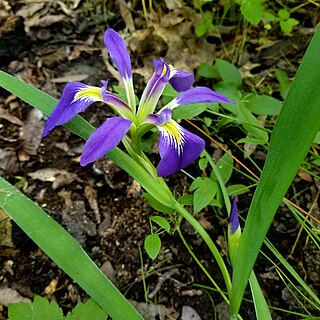
Lyme Park is a large estate south of Disley, Cheshire, England, managed by the National Trust and consisting of a mansion house surrounded by formal gardens and a deer park in the Peak District National Park. The house is the largest in Cheshire, and is recorded in the National Heritage List for England as a designated Grade I listed building.

Neston is a market town and civil parish on the Wirral Peninsula, in Cheshire, England. It is part of the unitary authority of Cheshire West and Chester. The civil parish and wider suburban area includes Parkgate to the north west and Little Neston, Ness and part of Burton to the south.

The M56 motorway, serves the Cheshire and Greater Manchester areas of England. It runs east to west from junction 4 of the M60 at Gatley, south of Manchester, to Dunkirk, approximately four miles north of Chester. With a length of 33.3 miles (53.6 km), it connects North Wales and the Wirral peninsula with much of the rest of North West England, serves business and commuter traffic heading towards Manchester, particularly that from the wider Cheshire area, and provides the main road access to Manchester Airport from the national motorway network.

The Wirral Peninsula, known locally as The Wirral, is an area in North West England. The roughly rectangular peninsula is about 15 miles (24 km) long and 7 miles (11 km) wide and is bounded by the River Dee to the west, the River Mersey to the east, and the Irish Sea to the north.

Bodnant Garden is a National Trust property near Tal-y-Cafn, Conwy, Wales, overlooking the Conwy Valley towards the Carneddau mountains.

Coade stone or Lithodipyra or Lithodipra is stoneware that was often described as an artificial stone in the late 18th and early 19th centuries. It was used for moulding neoclassical statues, architectural decorations and garden ornaments of the highest quality that remain virtually weatherproof today.

Iris giganticaerulea, the giant blue iris, is a species of iris, in the subgenus Limniris, in the series Hexagonae. It is a rhizomatous perennial, from northern America. It has long bright green leaves, very tall stems and one or two musky fragrant flowers in a range of blue shades or rarely white.

Ness is a village on the Wirral Peninsula, in the part that remains in the ceremonial county of Cheshire, England. It is situated near to the town of Neston, in the unitary authority of Cheshire West and Chester. It constitutes part of the Burton & Ness Ward of the district, with the ward having a total population of 1,620 in the 2001 Census.

Tatton Park Gardens consist of formal and informal gardens in Tatton Park to the south of Tatton Hall, Cheshire, England. Included in the gardens are an Italian garden, a walled garden, a rose garden, and the Japanese garden. The buildings in the garden are the Conservatory, the Fernery and the Showhouse. The gardens are owned by the National Trust and administered by Cheshire East Council. They are on the National Register of Historic Parks and Gardens and have been designated at Grade II*. The gardens are open to the public at advertised times.

George Forrest was a Scottish botanist, who became one of the first western explorers of China's then remote southwestern province of Yunnan, generally regarded as the most biodiverse province in the country.

Southport Botanic Gardens is a botanical garden situated in the suburban village of Churchtown, Southport, in Merseyside, England. It is often called "The Jewel in the Crown" as it is nationally known for its floral displays, which have been featured in the BBC TV program Gardener's World.
New Ferry Butterfly Park is a 2-hectare (4.9-acre) urban nature reserve in New Ferry, on the Wirral Peninsula, England. It is managed by the Cheshire Wildlife Trust.

Boris Alexeevich Fedtschenko was a Russian plant pathologist and botanist. He is primarily known for his work on various regions of Russia, especially the Caucasus, Siberia and Asiatic Russia. He was also head botanist at the Saint Petersburg Botanical Garden.

Iris brevicaulis is a species in the genus Iris, it is also in the subgenus Limniris and in the series Hexagonae. It is a rhizomatous perennial, from North America. It has bright green, glossy long leaves, a long zig-zagged stem and 3–6 flowers per stem, which are come in blue shades from violet-blue, to lavender, to purple-blue, to bright blue to blue, and pale blue.

Iris fulva, also known as copper iris, is a species in the genus Iris, it is also in the subgenus Limniris and in the series Hexagonae. It is a rhizomatous perennial, endemic to the southern and central United States. It has copper-red to deep red flowers and bright green leaves.

Iris bulleyana is a species in the genus Iris, also the subgenus Limniris and in the series Sibiricae. It is a rhizomatous herbaceous perennial, from South west China, including Myanmar and Tibet. It has long thin green leaves,
Arthur Kilpin Bulley was a British cotton merchant and creator of the Ness Botanic Gardens. He stood for Parliament as a women's suffrage candidate in 1910.
Agnes Lois Bulley (1901–1995) was a British county councillor, philanthropist and political activist from Cheshire, England.
















